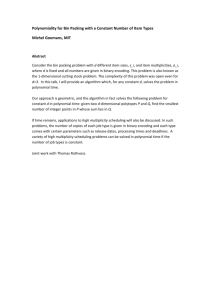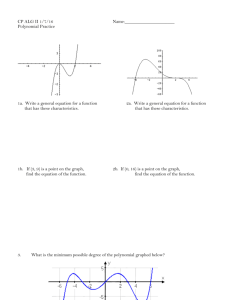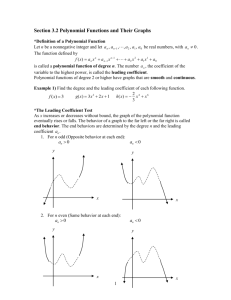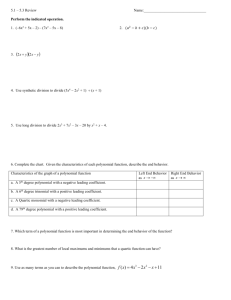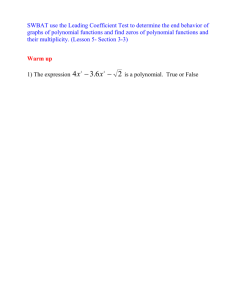Section 4.3 Class Notes
advertisement
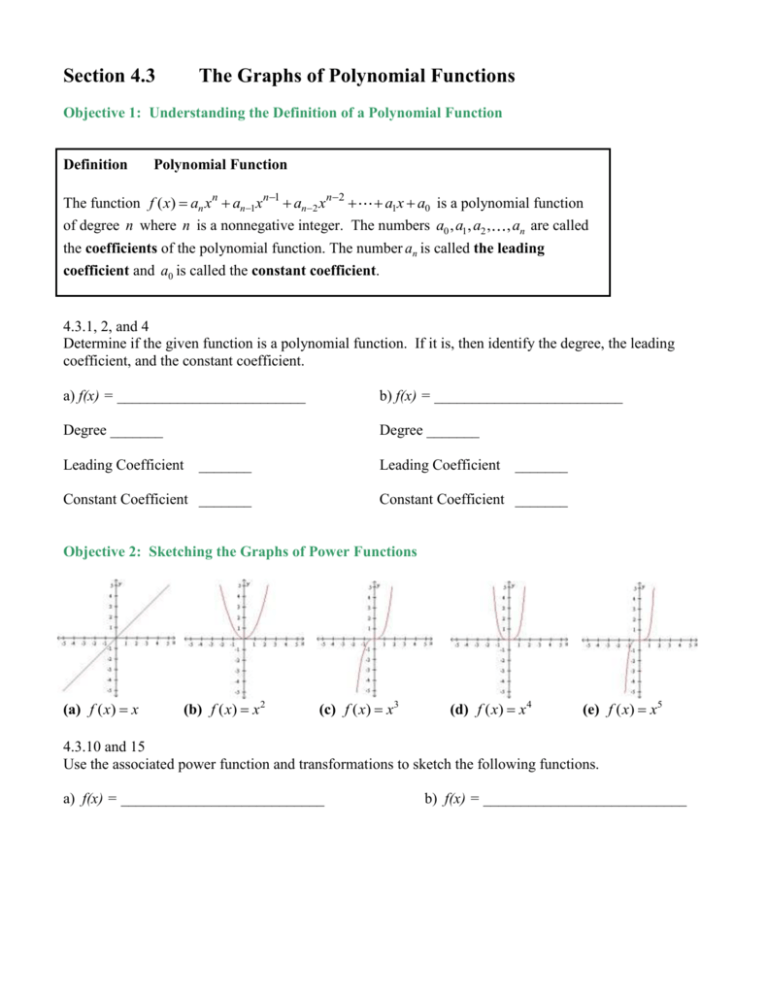
Section 4.3 The Graphs of Polynomial Functions Objective 1: Understanding the Definition of a Polynomial Function Definition Polynomial Function The function f ( x) an xn an1xn1 an2 xn2 a1x a0 is a polynomial function of degree n where n is a nonnegative integer. The numbers a0 , a1, a2 , , an are called the coefficients of the polynomial function. The number an is called the leading coefficient and a0 is called the constant coefficient. 4.3.1, 2, and 4 Determine if the given function is a polynomial function. If it is, then identify the degree, the leading coefficient, and the constant coefficient. a) f(x) = _________________________ b) f(x) = _________________________ Degree _______ Degree _______ Leading Coefficient _______ Leading Coefficient _______ Constant Coefficient _______ Constant Coefficient _______ Objective 2: Sketching the Graphs of Power Functions (a) f ( x) x (b) f ( x) x 2 (c) f ( x) x3 (d) f ( x) x 4 (e) f ( x) x5 4.3.10 and 15 Use the associated power function and transformations to sketch the following functions. a) f(x) = ___________________________ b) f(x) = ___________________________ Objective 3: Determining the End Behavior of Polynomial Functions Process for Determining the End Behavior of a Polynomial Function f ( x ) an x n an1 x n1 an 2 x n2 a1 x a0 . If the degree n is odd, the graph has opposite left-hand and right-hand end behavior, that is, the graph “starts” and “finishes” in opposite directions. Odd degree polynomials have opposite left-hand and right-hand end behavior. an 0 , odd degree an 0 , odd degree If the degree n is even, the graph has the same left-hand and right-hand end behavior, that is, the graph “starts” and “finishes” in the same direction. Even degree polynomials have the same left-hand and right-hand end behavior. an 0 , even degree an 0 , even degree 4.3.16 and 21 Use the end behavior of the graph of the given polynomial function to answer the following: 16 a)The degree is ______________ (even or odd). b) The leading coefficient is ______________ (positive or negative). 21 a)The degree is ______________ (even or odd). b) The leading coefficient is ______________ (positive or negative). Objective 4: Determining the Intercepts of a Polynomial Function The number x c is called a zero of a function f if f (c) 0 . If c is a real number, then c is an xintercept. Therefore, to find the x-intercepts of a polynomial function y f ( x) , we must find the real solutions of the equation f ( x) 0 . 4.3.23 Find the intercepts of the polynomial function f(x) = ___________________________. The y-intercept is y = ________. The x-intercept(s) is/are x = ____________________. 4.3.25 Find the intercepts of the polynomial function f(x) = ___________________________. The y-intercept is y = ________. The x-intercept(s) is/are x = ____________________. Objective 5: Determining the Real Zeros of Polynomial Functions and Their Multiplicities The Shape of the Graph of a Polynomial Function Near a Zero of Multiplicity k. Suppose c is a real zero of a polynomial function f of multiplicity k, that is, x c is a factor of f. Then the shape of the graph of f near x = c is as follows: k If k 1 is even, then the graph touches the x-axis at x = c. OR If k 1 is odd, then the graph crosses the x-axis at x = c. OR 4.3.30 Determine the real zeros and their multiplicities of f(x) = ___________________________. a) The real zeros of the polynomial are x = ____________________. (Use a comma to separate answers as needed. Type an exact answer, using radicals as needed.) b) The multiplicity of the zero located farthest left on the x-axis is _____. The multiplicity of the zero located farthest right on the x-axis is _____. The graph _________the x-axis at the leftmost zero. (touches or crosses) The graph __________ the x-axis at the rightmost zero. (touches or crosses) Objective 6: Sketching the Graph of a Polynomial Function Four-Step Process for Sketching the Graph of a Polynomial Function 1. Determine the end behavior. 2. Plot the y-intercept f (0) a0 . 3. Completely factor f to find all real zeros and their multiplicities*. 4. Choose a test value between each real zero and sketch the graph. * This is the most difficult step and will be discussed in further detail in the subsequent sections of this chapter. 4.3.36 Sketch the polynomial function f(x) = ____________________________ using the four-step process. The left-hand behavior starts _____ and the right-hand behavior ends _____. The y-intercept is _____. The real zeros of the polynomial are x = ____________________. The multiplicity of the zero located farthest left on the x-axis is _____. The multiplicity of the zero located between the leftmost and rightmost zeros is _____. The multiplicity of the zero located farthest right on the x-axis is _____. What is the value of the test point at x = _____? y = _____ Sketch the graph. Objective 7: Determining a Possible Equation of a Polynomial Function Given its Graph 4.3.45 Analyze the graph to address the following about the polynomial function it represents. a) Is the degree even or odd? __________ b) Is the leading coefficient positive or negative? __________ c) The value of the constant coefficient is _____. d) The leftmost real zero is x = _____, which has an _____ multiplicity. The second real zero from the left is x = _____, which has an _____ multiplicity. The second real zero from the right is x = _____, which has an _____ multiplicity. The rightmost real zero is x = _____, which has an _____ multiplicity. e) Select a possible function that could be represented by this graph.


